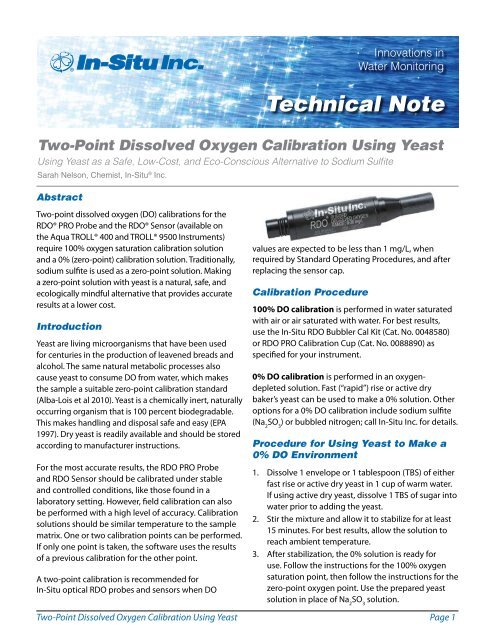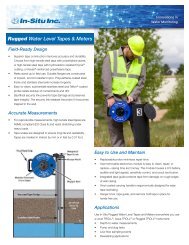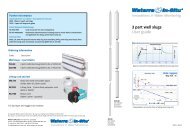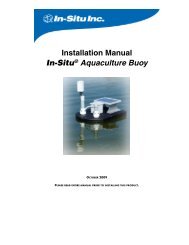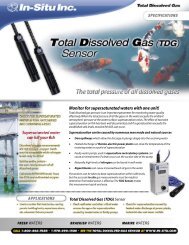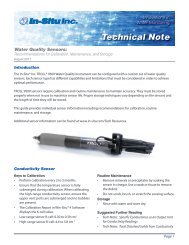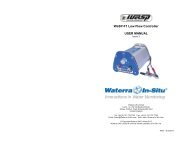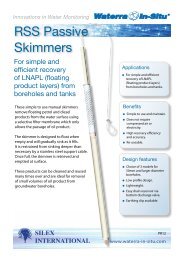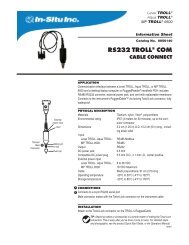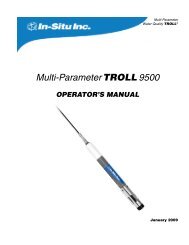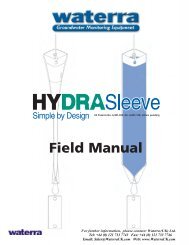2-Point DO Calibration using Yeast - Waterra-In-Situ
2-Point DO Calibration using Yeast - Waterra-In-Situ
2-Point DO Calibration using Yeast - Waterra-In-Situ
You also want an ePaper? Increase the reach of your titles
YUMPU automatically turns print PDFs into web optimized ePapers that Google loves.
Abstract<br />
<strong>In</strong>novations in<br />
Water Monitoring<br />
Technical Note<br />
Two-<strong>Point</strong> Dissolved Oxygen <strong>Calibration</strong> Using <strong>Yeast</strong><br />
Using <strong>Yeast</strong> as a Safe, Low-Cost, and Eco-Conscious Alternative to Sodium Sulfite<br />
Sarah Nelson, Chemist, <strong>In</strong>-<strong>Situ</strong> ® <strong>In</strong>c.<br />
Two-point dissolved oxygen (<strong>DO</strong>) calibrations for the<br />
R<strong>DO</strong>® PRO Probe and the R<strong>DO</strong>® Sensor (available on<br />
the Aqua TROLL® 400 and TROLL® 9500 <strong>In</strong>struments)<br />
require 100% oxygen saturation calibration solution<br />
and a 0% (zero-point) calibration solution. Traditionally,<br />
sodium sulfite is used as a zero-point solution. Making<br />
a zero-point solution with yeast is a natural, safe, and<br />
ecologically mindful alternative that provides accurate<br />
results at a lower cost.<br />
<strong>In</strong>troduction<br />
<strong>Yeast</strong> are living microorganisms that have been used<br />
for centuries in the production of leavened breads and<br />
alcohol. The same natural metabolic processes also<br />
cause yeast to consume <strong>DO</strong> from water, which makes<br />
the sample a suitable zero-point calibration standard<br />
(Alba-Lois et al 2010). <strong>Yeast</strong> is a chemically inert, naturally<br />
occurring organism that is 100 percent biodegradable.<br />
This makes handling and disposal safe and easy (EPA<br />
1997). Dry yeast is readily available and should be stored<br />
according to manufacturer instructions.<br />
For the most accurate results, the R<strong>DO</strong> PRO Probe<br />
and R<strong>DO</strong> Sensor should be calibrated under stable<br />
and controlled conditions, like those found in a<br />
laboratory setting. However, field calibration can also<br />
be performed with a high level of accuracy. <strong>Calibration</strong><br />
solutions should be similar temperature to the sample<br />
matrix. One or two calibration points can be performed.<br />
If only one point is taken, the software uses the results<br />
of a previous calibration for the other point.<br />
A two-point calibration is recommended for<br />
<strong>In</strong>-<strong>Situ</strong> optical R<strong>DO</strong> probes and sensors when <strong>DO</strong><br />
values are expected to be less than 1 mg/L, when<br />
required by Standard Operating Procedures, and after<br />
replacing the sensor cap.<br />
<strong>Calibration</strong> Procedure<br />
100% <strong>DO</strong> calibration is performed in water saturated<br />
with air or air saturated with water. For best results,<br />
use the <strong>In</strong>-<strong>Situ</strong> R<strong>DO</strong> Bubbler Cal Kit (Cat. No. 0048580)<br />
or R<strong>DO</strong> PRO <strong>Calibration</strong> Cup (Cat. No. 0088890) as<br />
specified for your instrument.<br />
0% <strong>DO</strong> calibration is performed in an oxygendepleted<br />
solution. Fast (“rapid”) rise or active dry<br />
baker’s yeast can be used to make a 0% solution. Other<br />
options for a 0% <strong>DO</strong> calibration include sodium sulfite<br />
(Na 2<br />
SO 3<br />
) or bubbled nitrogen; call <strong>In</strong>-<strong>Situ</strong> <strong>In</strong>c. for details.<br />
Procedure for Using <strong>Yeast</strong> to Make a<br />
0% <strong>DO</strong> Environment<br />
1.<br />
2.<br />
3.<br />
Dissolve 1 envelope or 1 tablespoon (TBS) of either<br />
fast rise or active dry yeast in 1 cup of warm water.<br />
If <strong>using</strong> active dry yeast, dissolve 1 TBS of sugar into<br />
water prior to adding the yeast.<br />
Stir the mixture and allow it to stabilize for at least<br />
15 minutes. For best results, allow the solution to<br />
reach ambient temperature.<br />
After stabilization, the 0% solution is ready for<br />
use. Follow the instructions for the 100% oxygen<br />
saturation point, then follow the instructions for the<br />
zero-point oxygen point. Use the prepared yeast<br />
solution in place of Na 2<br />
SO 3<br />
solution.<br />
Two-<strong>Point</strong> Dissolved Oxygen <strong>Calibration</strong> Using <strong>Yeast</strong> Page 1
<strong>Yeast</strong> vs. Sodium Sulfite as a Zero-<strong>Point</strong> <strong>Calibration</strong> Standard—% Saturation<br />
Comparison of R<strong>DO</strong> PRO Probe <strong>DO</strong> Readings in Sodium Sulfite, <strong>Yeast</strong> Solution,<br />
and 100% Air-Saturated Water<br />
Dissolved Oxygen % Saturation<br />
120<br />
100<br />
80<br />
60<br />
40<br />
20<br />
0<br />
-20<br />
<strong>Yeast</strong><br />
2M Sodium<br />
<strong>Yeast</strong><br />
2M Sodium<br />
5<br />
Solution<br />
Sulfite<br />
Solution<br />
Sulfite<br />
0<br />
0 1000 2000 3000 4000 5000 6000 7000<br />
Time (seconds)<br />
50<br />
45<br />
40<br />
35<br />
30<br />
25<br />
20<br />
15<br />
10<br />
Temperature (Celsius)<br />
R<strong>DO</strong> <strong>DO</strong> %Sat<br />
R<strong>DO</strong> Temp<br />
The above graph shows <strong>DO</strong> saturation readings, alternating between 100% and 0% saturation. The 0% saturation<br />
readings were recorded by alternating between a prepared yeast solution and a 2 M Na 2<br />
SO 3<br />
solution. The data<br />
indicates that there is no significant variance between 0% <strong>DO</strong> readings when <strong>using</strong> a yeast solution versus <strong>using</strong> a<br />
Na 2<br />
SO 3<br />
solution. Additionally, there is no affect on 100% saturation readings when utilizing either solution. Note: minor<br />
temperature variations are due to solution cooling in ambient conditions, which does not significantly effect results.<br />
Average <strong>DO</strong> Readings<br />
mg/L<br />
% Saturation<br />
<strong>Yeast</strong> Solution 0.0063 0.105%<br />
Water Saturated Air 6.951 104.57%<br />
(after yeast solution)<br />
Sodium Sulfite 0.004 0.056%<br />
Water Saturated Air<br />
(after sodium sulfite)<br />
7.273 103.49%<br />
References<br />
1. Alba-Lois, L. & Segal-Kischinevzky, C. 2010. Beer and<br />
wine makers. Nature Education 3(9):17 (http://www.<br />
nature.com/scitable/topicpage/yeast-fermentationand-the-making-of-beer-14372813).<br />
Resourced<br />
from web March 21, 2012.<br />
2. EPA Report. February 1997. Saccharomyces<br />
cerevisiae Final Risk Assessment. (http://www.epa.<br />
gov/biotech_rule/pubs/fra/fra002.htm). Resourced<br />
from web March 21, 2012.<br />
For more information, contact <strong>In</strong>-<strong>Situ</strong> <strong>In</strong>c.<br />
221 East Lincoln Avenue, Fort Collins, CO 80524<br />
1-800-446-7488 (toll-free in U.S. & Canada)<br />
1-970-498-1500 (international & domestic)<br />
www.in-situ.com April 2012/rev. 01<br />
<strong>In</strong>-<strong>Situ</strong>, the <strong>In</strong>-<strong>Situ</strong> logo, Baro Merge, BaroTROLL, HERMIT, Pocket-<strong>Situ</strong>, R<strong>DO</strong>, RuggedCable, RuggedReader, TROLL, and Win-<strong>Situ</strong> are registered trademarks of <strong>In</strong>-<strong>Situ</strong> <strong>In</strong>c. © 2012.<br />
Two-<strong>Point</strong> Dissolved Oxygen <strong>Calibration</strong> Using <strong>Yeast</strong> Page 2


